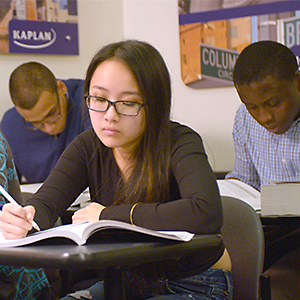The ACT remains, as it has since 2010, the more popular of the two
standardized college entrance exams. The recently redesigned SAT, however,
appears to be making inroads and may, for some students, be the better
test. While 82 percent of high school students feel the revised SAT is
fair, 94 percent say they would recommend the ACT, according to a poll by
Magoosh, a national online test-prep service.
Despite that purported preference, teens have not forgone the SAT. Of
students in the class of 2017, about 1.7 million took the new SAT and 2
million took the ACT. “I believe the SAT stands a good chance of having
kids warm up to it,” says Bhavin Parikh, Magoosh’s CEO and founder.
Today’s SAT more closely resembles the ACT, which means that the test is
designed to reflect classroom learning rather than test preparation, says
Matt Mangelsen, program director at Capital Educators. “That’s actually
advantageous to the student,” he says. “You used to have separate tracks in
preparing for the tests, now, for the most part, you can prepare
simultaneously for both.”
Deciding which test is best for an individual student is as much an art as
it is a science. Some college test-prep professionals believe there is a
way to predict preference, others think experience with both is essential.
Understanding the differences between the two tests can inform a student’s
decision.
Both tests take roughly three hours to complete, not counting the optional
essay. The ACT has four sections: English, reading, math and science. The
SAT has three sections: English, reading and math. So timing varies for
each section. For example:
|
Section |
ACT |
SAT |
|
English |
45 minutes 75 questions |
35 minutes 44 questions |
|
Reading |
35 minutes 40 questions |
65 minutes 52 questions |
|
Math |
60 minutes 60 questions |
80 minutes 58 questions |
|
Science |
35 minutes 40 questions |
N/A |
“Time is a consideration,” says Parikh. “If a student tends to struggle
with time and not finish tests, the SAT might be a better choice,” he says.
Overall, across sections, students have an average of 50 seconds per
question on the ACT and 70 seconds per question on the SAT, according to
the Magoosh website.
Time made a difference in Cameron Wheeden’s success on the SAT. “I felt
more rushed with the ACT,” says the Walter Johnson High School (WJHS)
senior. “I don’t work well under pressure and found that with the ACT I ran
out of time and ended up randomly bubbling in answers. With the SAT, I had
more time to work, even though the questions were a bit harder.”
The reverse was true for WJHS senior Ryan Cutler who, after taking the PSAT
in 10th and 11th grades, opted for the ACT. “With the
PSAT, and I suppose the SAT, you have more time because the questions are
more difficult and tedious. I found the ACT was more straightforward and
gave me the right amount of time.”
Confidence in and enjoyment of certain academic subjects also are factor in
choosing which test to take. “Generally students who love and do well in
science may find the ACT a better fit,” says Parikh.
Only the ACT offers a section exclusively dedicated to science. That was
important to Cutler. “The ACT was more subject oriented and tied to the
curriculum, which was beneficial to me. I
felt as though the science section played to my academic strengths,” he
says.
The ACT also allows the use of a calculator for all math problems, whereas
the SAT has two math sections, only one of which permits a calculator.
“Students who love mental math and trick problems may prefer the SAT, but
those who prefer straightforward math with a calculator may be better off
with the ACT,” says Parikh.
“Students who are avid readers tend to do better on the SAT,” says Parikh.
Because of the way the ACT is scored, “if a student is not strong in
reading he can mask it a bit more on the ACT.”
The scoring of both tests, and the way colleges approach those scores, may
also influence a student’s decision as to whether to take the ACT or SAT.
Many schools will super score the SAT but not the ACT. That means they take
the highest SAT math and reading scores, even if the tests were taken on
different days. “The reluctance of schools to super score the ACT has to do
with the fact that there are four scores as opposed to two for the SAT,”
says Mangelsen.
That is part of the reason Bradford Clarkson, a WJHS senior, opted to take
the SAT a second time rather than switch to the ACT. Having scored well on
math, his goal was to improve his English/reading score. He was able to do
so without worrying about his math score.
Based on anecdotal evidence, it appears that many students choose one test
and stick with it, which is not what test-prep services suggest. The
recommendation is that students take both the ACT and the SAT and, based on
the results, take one of the tests a second time. “There’s no disadvantage
to taking both,” says Mangelsen, as students do not have to report every
score to a college. There is, however, a point of diminishing returns, he
noted. That often comes after taking any combination of the ACT and SAT
more than three times.
Repeated test taking can create stress and reduce a student’s performance,
which Wheeden can attest to. “While I’m happy with the way things turned
out, if I could change anything it would have been to focus on one test,
the SAT, and I would have saved myself the stress,” he says.
Special needs students face additional considerations. “The type of
accommodations offered for the ACT and SAT vary,” according to Jody
Bleiberg, a licensed psychologist in private practice in Bethesda, MD.
While there are a number of hoops to jump through, Bleiberg says she has
found that both testing bodies “want to do the right thing by students as
long as they are legally protected.”
For Ethan Hughes, a senior at Walt Whitman High School in Bethesda, the ACT
was a better indicator of his academic abilities than the SAT. That’s
because the ACT allowed him to take each of the four sections on a
different day and in a private setting. “With the SAT I was in a classroom
with a small number of other students and had to wait for everyone to
finish before I could continue. It was difficult given that, even though I
have extended time, I tend to go faster. The result was that my SAT score
was worse than my PSAT,” he says.
While there is no crystal ball that can determine with 100 percent accuracy
which test a student should take, Parikh has posted a short survey on the
Magoosh website that, based on a student’s responses, provides some insight
into which test might be a better fit.
No matter which test a student opts to take, Mangelsen believes it’s
important to maintain some perspective. “The ACT and SAT are just one of
several factors a school considers in deciding whether to admit a student.
Yes, they are important. But they are not the sole determinant,” he says.


